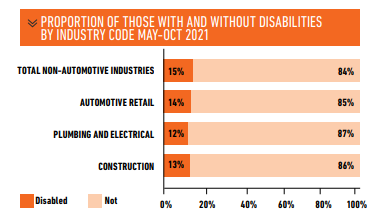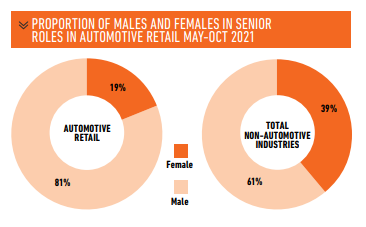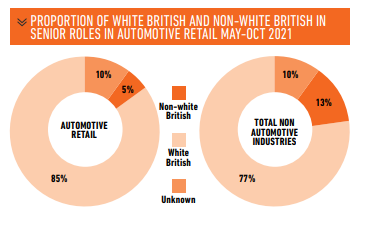An Institute of the Motor Industry (IMI) report aiming to be the catalyst of a shift to greater diversity, inclusion and equity in automotive has revealed that gender remains the source of the sector’s most significant representation imbalance.
The industry body’s Diversity Task Force assembled experts in working groups focused on physical and nonvisible disabilities, race and ethnicity and gender and sexual orientation to gather evidence and insight to create the report.
And, while the IMI was “surprised” to find that the automotive sector employs a larger than average proportion of individuals with disabilities, its findings also highlighted the significant work still needed to tip the balance of representation.
DISABILITY FIGURES
The Diversity Tasks Force’s research, carried out between May and October last year, identified that 14% of the automotive retail workforce had a disability, with 16% of sales staff and 26% of those working in parts and accessories having some level of disability.
 This compared with 15% in nonautomotive industries.
This compared with 15% in nonautomotive industries.
Office for National Statistics (ONS) data related to the ethnicity of the sector, meanwhile, showed 81% of the automotive retail sector’s employees identified as white-British, compared with 56% in other industries, prompting the report to conclude: “Non-white British are significantly under-represented in the automotive retail sector.”
In gender terms, the same data set showed that male employees account for 81% of automotive retail employees, amounting to the sector’s largest disparity in representation, and backing up perceptions that the sector its largely populated by white men.
 The report said: “In the non-automotive industries, the gender split is 49% males and 51% females. The underrepresentation of females is the most significant of all variables tested.”
The report said: “In the non-automotive industries, the gender split is 49% males and 51% females. The underrepresentation of females is the most significant of all variables tested.”
The Diversity Task Force said it was possible to establish from the data that there are less than 5% of women in vehicle technician, mechanic and electrician occupations and in vehicle paint technician occupations.
Furthermore, the report identified that the issue of diverse representation became particularly critical the higher up the pay grade.
 IMI analysis of ONS data for the sector found that the proportion of non-white-British in senior roles in automotive retail (5%) is significantly less than those in senior roles not in automotive (13%).
IMI analysis of ONS data for the sector found that the proportion of non-white-British in senior roles in automotive retail (5%) is significantly less than those in senior roles not in automotive (13%).
There are also just 19% of women in senior roles in automotive compared with 39% in non-automotive.
However, there are proportionally more disabled individuals in senior roles in automotive retail (15%) compared with those in senior roles outside of automotive (12%) when taking into account hidden disabilities such as dyslexia, ADHD and other areas of neurodiversity.
FOCUS ON GENDER
Automotive 30% Club founder Julia Muir, who served as the gender and sexual orientation working group’s industry expert, said: “One of the aims of the Diversity Task Force was to broaden the discussion beyond gender. I hope that the findings bring the focus back on to gender.
“The report gives some really simple, easy-to-implement recommendations which aim to cut bias and discrimination which, if implemented, should see a greater female representation in the sector introduced in tandem with greater diversity from a broader perspective.”
 IMI president professor Jim Saker, who was inspired to launch the Diversity Task Force in response to feedback to one of his monthly columns in AM, said: “The task force set out to understand how the sector can be more attractive to work in for all individuals.
IMI president professor Jim Saker, who was inspired to launch the Diversity Task Force in response to feedback to one of his monthly columns in AM, said: “The task force set out to understand how the sector can be more attractive to work in for all individuals.
“We wanted to understand what groups are under-represented and what the experience is like if you are Task force identifies notable imbalances in terms of gender and ethnicity not part of the majority so we can bring the issue of diversity and inclusion to the top of the agenda for automotive businesses.
“What has been particularly striking is that the lack of diversity – which, unfortunately, is already poor in our sector – becomes even more pronounced the higher up the pay grade.
“Without diverse role models the sector will struggle to attract the talent we urgently need as we face the biggest skills shortage for more than 20 years.”
According to the IMI, automotive vacancies are at their highest level for 20 years – at more than 23,000 – accounting for approximately 4% of the workforce.
It said that a more diverse workforce As critical to turn the tide and the lack of role models is a fundamental barrier to achieving that goal.
Ensuring the sector is made to appeal to a more diverse talent pool is also vital.
In its comments on diversity, submitted to the report, Jardine Motor Group said: “Based on our external research in 2015, just 2% of women identified automotive as an industry where they could progress a career with 31% of those surveyed referencing automotive as a ‘macho’ environment.
“While the research was in 2015, we believe these perceptions remain.”
IMI chief operations officer Lesley Woolley said: “All the task force working groups said culture needs to change, behaviours need to change.
“That change needs buy-in from senior leadership. Each of the working groups also calls for the industry to openly share more data on the make-up of the workforce to provide the benchmark to reflect on and measure against.”
IN-DEPTH RECOMMENDATIONS
As part of its report, the Diversity Task Force has published a five-stage call to action for automotive employers (top right) to engage with the task of diversifying their workforce alongside a series of more in-depth recommendations from each of its working groups.
Among the recommendations working groups urged automotive sector employers to: make sure their jobs boards reached a more diverse audience; promote their diverse workforce via social media; remove gender and ethnicity indicators from CVs to ensure unbiased recruitment.
The physical and non-visible disabilities working group recommended membership of the Business Disability Forum to access advice, self-assessment, business audit, toolkits and frameworks to help remove barriers for disabled people in the business structure.
A reverse mentoring scheme – as pioneered by accountancy firm KPMG – was recommended by the race and ethnicity working group, meanwhile.
This would see employees with black heritage paired with those working at more senior levels to help them understand the workplace challenges faced by people from diverse backgrounds.
As well as publishing its new report, the IMI indicated it would be partnering with organisations and businesses to help further their diversity, inclusion and equity ambitions. It may also host Dragons Den-style annual competitions to come up with new industry initiatives to promote diversity in the sector.
Woolley also advised that automotive employers start to “openly share more data on the make-up of the workforce to provide the benchmark to reflect on and measure against”.
IMI chief executive Steve Nash said: “The work of the task force has clearly identified changes that need to be made by the sector, but it has also challenged our own perceptions and work practices.
“At times it has been uncomfortable, but diversity and inclusion are of strategic importance to us, and so we have already made changes to the way we work and will continue to make more.”
THE IMI’S FIVE-STAGE ACTION PLAN
Strategic importance: signal your commitment to the whole business by putting diversity and inclusion on every board and senior leadership team agenda.
- Know your workforce: many people choose not to share information about disability, gender, sexual orientation, religion, ethnicity etc., with their employer. Make a commitment to understand your staff through better data collection and communication.
- Small changes, big difference: many workplace changes or adaptations require little investment but can significantly improve someone’s ability to perform their job. Commit to asking staff what changes would make a big difference to them.
- New perspective: commit to reviewing everything through a new ‘lens’ of diversity, equity and inclusion. Look at your policies, procedures, website, customer journey and ways of working and collaborating with colleagues to create an inclusive environment.
- Change perceptions: to attract and retain talent into the automotive sector we need to clearly demonstrate that great career opportunities are open to all. Commit to proudly showcase a diverse senior leadership team or use diverse role models in outreach programmes for schools, for example. If you are proud to work in automotive, shout about it.















Login to comment
Comments
No comments have been made yet.